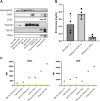Validation of Effective Extracellular Vesicles Isolation Methods Adapted to Field Studies in Malaria Endemic Regions
- PMID: 35652104
- PMCID: PMC9149222
- DOI: 10.3389/fcell.2022.812244
Validation of Effective Extracellular Vesicles Isolation Methods Adapted to Field Studies in Malaria Endemic Regions
Abstract
Malaria affects the poorer regions of the world and is of tremendous health and economic burden for developing countries. Extracellular vesicles (EVs) are small vesicles released by almost any cells in the human body, including malaria infected red blood cells. Recent evidence shows that EVs might contribute to the pathogenesis of malaria. In addition, EVs hold considerable value in biomarker discovery. However, there are still significant gaps in our understanding of EV biology. So far most of our knowledge about EVs in malaria comes from in vitro work. More field studies are required to gain insight into their contribution to the disease and pathogenesis under physiological conditions. However, to perform research on EVs in low-income regions might be challenging due to the lack of appropriate equipment to isolate EVs. Therefore, there is a need to develop and validate EV extraction protocols applicable to poorly equipped laboratories. We established and validated two protocols for EV isolation from cell culture supernatants, rodent and human plasma. We compared polyethylene glycol (PEG) and salting out (SA) with sodium acetate for precipitation of EVs. We then characterized the EVs by Transmission Electron Microscopy (TEM), Western Blot, Size-exclusion chromatography (SEC), bead-based flow cytometry and protein quantification. Both protocols resulted in efficient purification of EVs without the need of expensive material or ultracentrifugation. Furthermore, the procedure is easily scalable to work with large and small sample volumes. Here, we propose that both of our approaches can be used in resource limited countries, therefore further helping to close the gap in knowledge of EVs during malaria.
Keywords: Plasmodium falciparum; extracellular vesicles; malaria; microvesicles; polyethylene glycol precipitation; salting-out.
Copyright © 2022 Zoia, Yesodha Subramanian, Eriksson, Ravi, Yaghmaei, Fellay, Scolari, Walch and Mantel.
Conflict of interest statement
The authors declare that the research was conducted in the absence of any commercial or financial relationships that could be construed as a potential conflict of interest.
Figures






Similar articles
-
Precipitation with polyethylene glycol followed by washing and pelleting by ultracentrifugation enriches extracellular vesicles from tissue culture supernatants in small and large scales.J Extracell Vesicles. 2018 Oct 17;7(1):1528109. doi: 10.1080/20013078.2018.1528109. eCollection 2018. J Extracell Vesicles. 2018. PMID: 30357008 Free PMC article.
-
Comparing small urinary extracellular vesicle purification methods with a view to RNA sequencing-Enabling robust and non-invasive biomarker research.Biomol Detect Quantif. 2019 Jun 4;17:100089. doi: 10.1016/j.bdq.2019.100089. eCollection 2019 Mar. Biomol Detect Quantif. 2019. PMID: 31194192 Free PMC article.
-
Extracellular vesicles in malaria: an agglomeration of two decades of research.Malar J. 2021 Nov 20;20(1):442. doi: 10.1186/s12936-021-03969-8. Malar J. 2021. PMID: 34801056 Free PMC article. Review.
-
Charge-based precipitation of extracellular vesicles.Int J Mol Med. 2016 Nov;38(5):1359-1366. doi: 10.3892/ijmm.2016.2759. Epub 2016 Sep 29. Int J Mol Med. 2016. PMID: 28025988 Free PMC article.
-
Preparation and characterization of extracellular vesicles.Am J Reprod Immunol. 2021 Feb;85(2):e13367. doi: 10.1111/aji.13367. Epub 2020 Nov 16. Am J Reprod Immunol. 2021. PMID: 33118232 Review.
Cited by
-
Investigation of Plasma-Derived Lipidome Profiles in Experimental Cerebral Malaria in a Mouse Model Study.Int J Mol Sci. 2022 Dec 28;24(1):501. doi: 10.3390/ijms24010501. Int J Mol Sci. 2022. PMID: 36613941 Free PMC article.
-
Comparative study on drug encapsulation and release kinetics in extracellular vesicles loaded with snake venom L - amino acid oxidase.BMC Pharmacol Toxicol. 2025 May 8;26(1):98. doi: 10.1186/s40360-025-00938-8. BMC Pharmacol Toxicol. 2025. PMID: 40340782 Free PMC article.
References
-
- Antwi-Baffour S., Malibha-Pinchbeck M., Stratton D., Jorfi S., Lange S., Inal J. (2020). Plasma mEV Levels in Ghanain Malaria Patients with Low Parasitaemia Are Higher Than Those of Healthy Controls, Raising the Potential for Parasite Markers in mEVs as Diagnostic Targets. J. Extracell Vesicles 9, 1697124. 10.1080/20013078.2019.1697124 - DOI - PMC - PubMed
LinkOut - more resources
Full Text Sources
Miscellaneous

